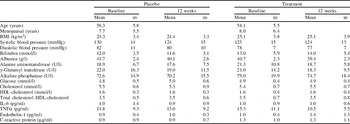The intake of anthocyanins, a subclass of flavonoids that confers the red, blue and purple colours to plant-based foods such as berries, apples and blackcurrants (Ribes nigrum), has been shown in epidemiological studies to be negatively correlated with CVD risk(Reference Mink, Scrafford and Barraj1). In vitro, anthocyanins also exhibit activities in keeping with a protective effect, such as reduced immune cell-activated radical, cytokine and adhesion molecule production(Reference Xia, Ling and Zhu2,Reference Rechner and Kroner3) and reduced NO activity(Reference Pergola, Rossi and Dugo4). However, to date there is limited evidence on the effects of consumption of physiologically-relevant doses of anthocyanins on biomarkers of CVD risk and safety biomarkers(Reference Hooper, Kroon and Rimm5).
In this randomised parallel placebo-controlled study the effect of 12 weeks of consumption of 500 mg anthocyanins (present predominantly in the cyanidin glycoside form; from elderberry (Sambucus nigra))/d, on biomarkers of CVD risk and liver and kidney function was examined in fifty-two healthy women (anthocyanins, n 26; placebo, n 26). Eligible participants were post-menopausal women (no menstruation for ≥12 months) under 70 years of age, not taking hormone-replacement therapy (HRT) for ≥6 months and with BMI between 20 kg/m2 and 32 kg/m2. Fasting blood samples were collected at baseline and 12 weeks and used to assess a series of vascular biomarkers and liver and kidney function, as indicated in the Table. In addition, platelet reactivity was assessed at 0 and 2 h at both baseline and end of the study.
Table. Characteristics of the study population and the effect of 12-week consumption of anthocyanins on biomarkers of CVD risk and liver and kidney function

The results suggest that biomarkers of liver and kidney function and CVD risk (blood pressure, lipid fractions and inflammatory biomarkers; also platelet reactivity (data not presented)) were not modified by 12 weeks of anthocyanins-rich elderberry consumption. In conclusion, these data suggest that daily consumption of physiologically-relevant doses of elderberry extract did not induce detrimental changes to liver and kidney function, but also did not alter biomarkers of CVD risk.



